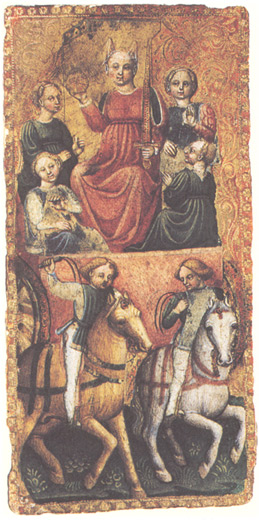Huck
Christie's auction house card
Visconti/Sforza Queen of Coins
The auction house Christie in Paris offered for 17th March 2005 a single Tarot card without informations to its origin, generally dating it to 15th century (168 x 83 mm). The estimated selling price was said to be 25,000 to 35,000 Euros.
Later addition: We've heard, that the price ended with 280.000 Euro (?).
Identification by trionfi.com
It's rather obvious by iconographical comparition and by the size of the cards, that this card belongs to the Warsaw cards (Kaplan, Encyclopedia of Tarot I, p. 108/109). Michael Dummett gives as the size of these cards (169 x 83) with a minimal difference to the Christie card.
(autorbis).
see card at:
http://trionfi.com/0/j/d/christie/
Ross Caldwell in the Cristina Fiorini thread gave the opinion (of Depaulis), that the single Ferrarese card ...
more details to this Depaulis statement
http://trionfi.com/0/j/d/ferrasingle/

... belongs to the Warsaw cards.
Generally in matters of the Warsaw cards perhaps one should ask the "stupid question" for the provenance of these cards.
How did they come just to Warsaw?
In this context it's PERHAPS interesting to know, that a Sforza-princess (Bona of Sforza) married to Polonia and became there Queen of Polonia. This happened rather late - in the year 1518.

http://en.wikipedia.org/wiki/Bona_Sforza
... and if we think this stupid question to its end, we have a rather big (?) behind the dating of the single Ferrarese card for ca. 1455.
In this context we may also think of these two Sforza cards in Hannover, Germany, Kestner Museum.
Kaplan I, p. 108
There is the same stupid question ... how do these cards come just to Germany?
Now is this style of the cards a little different of the other Tarocchi cards, even me can see this, so I think other can see this also. Naturally it's better in colours and higher resolution, which I don't have at hand.
I could imagine, that these is the refined late 15th century Sforza-style from Birago or Ambrogio de Predis - pictures of them you find by the image-search-function of google.
Birago worked for Bona of Savoyen, mother of Bianca Maria Sforza ... in the early 90's of 15th century, short before Bianca Maria went off to marry Emperor Maximilian.
Ambrogio de Predis accompanied Bianca Maria on her journey to Innsbruck 1493/94 to her final wedding. At the wedding evening .. before the night ... the bride showed the cards to her new husband. They did lead an engaged exchange about them.
Well, having no further information .... what shall one say. It are just stupid questions.
And ... just in the mood to ask VERY STUPID questions ... how came the Charles VI. cards to Paris ? ... and when married the first Italian princess to the French court?
Oh ... that seems rather late ... Katharina de Medici, somehow after 1530 ... but she was really from Florence.
Well, the costumes analysts said ca. 1470. But if these playing card painters prefered to show "old costumes" - just cause of nostalgic Italian feelings?

